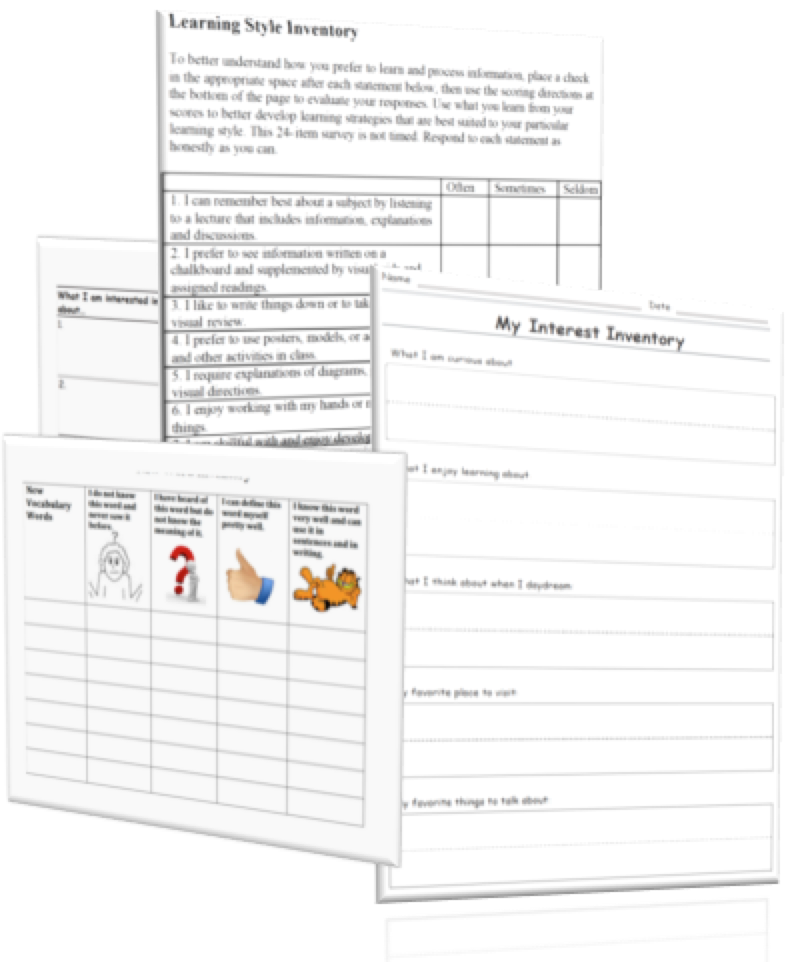Interests and Learning Styles
no insert
2. Interest Inventories
Informal Assessments
See The Teacher's Cafe for Inventories and other Assessments: http://theteacherscafe.com/Teacher-Directory/Reading-Assessments.htm
Also see the Course Objectives | Research | Materials folder, and the Reading Formative Assessments folder in this module
Informal reading assessments are qualitative assessments that measure the following:
- Grade level reading
- Fluency
- Comprehension

- Vocabulary
- Oral reading accuracy
Often ELLs will avoid reading altogether. They have come to dislike it for a number of reasons: they just don't like to read, are avoiding the act of reading altogether, or because classroom reading material is too difficult. They don’t like to be embarrassed reading aloud, getting "caught" not understanding what they read, and have simply become frustrated because the task of reading. Study after study has shown that students who read independently practice their reading skills and become better readers as a result. These are the motivated readers, motivated either by a good grade, the read itself, or because they are students who like to achieve. Struggling readers, different story.
Whether the child is a struggling reader or an unmotivated reader, finding his/her independent, instructional, and frustration reading levels is a necessary first step in motivating him/her to read. Equally as important, finding out what interests them in the topics they like to read about, genres (fiction, non-fiction, articles, editorials, car magazines, etc.). Administering an interest inventory at the beginning of the school year can help us to identify the reading materials likely to engage them, as well as identify follow-up activities to further engage and keep them reading and learning such as literature circles, book clubs, projects, and even writing topics for follow-up reading.
Interview and Reading Inventory Suggestions:
Student interviews: Students can interview one another and report back results, or teachers can interview them via survey or personal student-teacher conferences. Very young and/or struggling readers may need to have the survey questions read aloud to them, or one can be developed online using visuals and prompts. You might also conduct a survey of reading interests in small groups. Collect five or six titles from your library from a few different genres (folk tales, humor, fantasy, realistic fiction, etc.).
Conduct book reads yourself, or invite the school librarian or media specialist in to conduct a book read. Display the books in front of the group, showcasing the cover and backside pictures. Tell students what you're about to do, and follow with a reading of the title, first page or paragraph, and a few "blurbs" on the inside cover to get them interested. Don't give away the ending! Ask for a show of hands or a fist-to-five technique to let you know how many are interested in the book, and if the story interests them. After reviewing all of the books, immediately invite them up to check them out (have the library stamp or database on hand). A good reading attitude survey can be found in the Elementary Reading Attitude Survey by McKenna and Kear (1990).
After the Interview or Survey
Gather the inventory or interview data and create a file for each student. You can keep the data on an index card, sticky note, log on a clipboard, or in an online database. Use the data to place them in appropriately leveled books (as determined through benchmark assessments).
Give each student a copy of his/her quantified data so that they can be reminded of what their interests are, level of reading for independent and instructional, and any other information pertinent to their making proper independent choices for reading. Remember the ultimate goal: placing the right book in their hands so that they will want to read, and read on their own frequently.
References:
Taylor, B. M., Frye, B. J., & Maruyama, G. M. (1990). Time spent reading and reading growth. American Educational Research Journal, 27 (2), 351-362.
McKenna, M.D., & Kear, D. J. (1990). Measuring attitude toward reading: A new tool for teachers. The Reading Teacher, 43(9), 626-639. Retrieved July, 2009: http://faculty.rcoe.appstate.edu/koppenhaverd/f06/3030/readings/mckenna&kear.pdf
Keeping Students Motivated About Learning:
- Give students access to a wide choice of reading material and allow them to choose what they want to read.
- Provide a classroom library which has books on many reading levels, as well as magazines, newspapers, graphic novels, and comic books. In the absence of an extensive classroom library, schedule a weekly trip to the school library for students to select and check out books.
- Read aloud to students daily, and model good, effective oral reading with tone, intonation, and high engagement - be a good model of oral reading.
- Tape book reads and have students check out the book and the audio taped readings of them. Invite your administrators, counselors, and special area teachers (physical education, art, music, etc.) to record their reading of the book for students to check out (students will get a kick out of hearing their other teachers read). Students need to see and hear good role models engaged in reading.
- Invite special area teachers to read to your students live when possible.
Adapted from: Using Interest Inventories with Struggling and Unmotivated Readers, By Arleen P. Mariotti